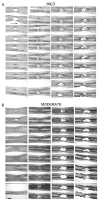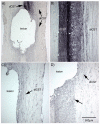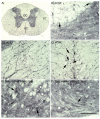Bilateral cervical contusion spinal cord injury in rats
- PMID: 19559699
- PMCID: PMC2761499
- DOI: 10.1016/j.expneurol.2009.06.012
Bilateral cervical contusion spinal cord injury in rats
Abstract
There is increasing motivation to develop clinically relevant experimental models for cervical SCI in rodents and techniques to assess deficits in forelimb function. Here we describe a bilateral cervical contusion model in rats. Female Sprague-Dawley rats received mild or moderate cervical contusion injuries (using the Infinite Horizons device) at C5, C6, or C7/8. Forelimb motor function was assessed using a grip strength meter (GSM); sensory function was assessed by the von Frey hair test; the integrity of the corticospinal tract (CST) was assessed by biotinylated dextran amine (BDA) tract tracing. Mild contusions caused primarily dorsal column (DC) and gray matter (GM) damage while moderate contusions produced additional damage to lateral and ventral tissue. Forelimb and hindlimb function was severely impaired immediately post-injury, but all rats regained the ability to use their hindlimbs for locomotion. Gripping ability was abolished immediately after injury but recovered partially, depending upon the spinal level and severity of the injury. Rats exhibited a loss of sensation in both fore- and hindlimbs that partially recovered, and did not exhibit allodynia. Tract tracing revealed that the main contingent of CST axons in the DC was completely interrupted in all but one animal whereas the dorsolateral CST (dlCST) was partially spared, and dlCST axons gave rise to axons that arborized in the GM caudal to the injury. Our data demonstrate that rats can survive significant bilateral cervical contusion injuries at or below C5 and that forepaw gripping function recovers after mild injuries even when the main component of CST axons in the dorsal column is completely interrupted.
Figures










References
-
- Anderson KD. Targeting recovery: priorities of the SCI population. J. Neurotrauma. 2004;21:1371–1383. - PubMed
-
- Anderson KD, Gunawan A, Steward O. Quantitative behavioral analysis of forepaw function after cervical spinal cord injury in rats: Relationship to the corticospinal tract. Exp. Neurol. 2005;194:161–174. - PubMed
-
- Anderson KD, Gunawan A, Steward O. Spinal pathways involved in the control of forelimb motor function in rats. Exp. Neurol. 2007;206:318–331. - PubMed
-
- Bareyre FM, Kerschensteiner M, Raineteau O, Mettenleiter TC, Weinmann O, Schwab ME. The injured spinal cord spontaneously forms a new intraspinal circuit in adult rats. Nat. Neurosci. 2004;7:269–277. - PubMed
Publication types
MeSH terms
Substances
Grants and funding
LinkOut - more resources
Full Text Sources
Medical
Miscellaneous

